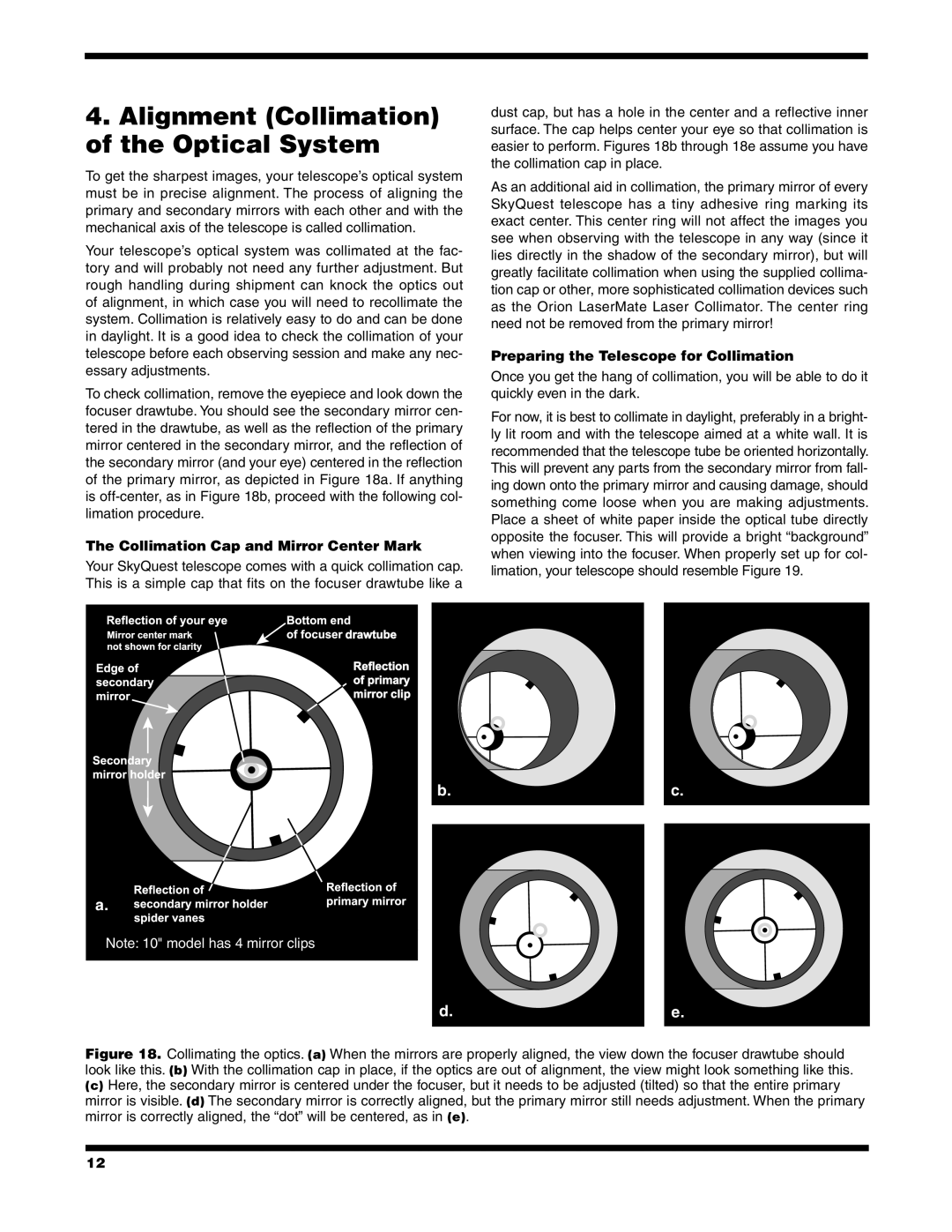
4.Alignment (Collimation) of the Optical System
To get the sharpest images, your telescope’s optical system must be in precise alignment. The process of aligning the primary and secondary mirrors with each other and with the mechanical axis of the telescope is called collimation.
Your telescope’s optical system was collimated at the fac- tory and will probably not need any further adjustment. But rough handling during shipment can knock the optics out of alignment, in which case you will need to recollimate the system. Collimation is relatively easy to do and can be done in daylight. It is a good idea to check the collimation of your telescope before each observing session and make any nec- essary adjustments.
To check collimation, remove the eyepiece and look down the focuser drawtube. You should see the secondary mirror cen- tered in the drawtube, as well as the reflection of the primary mirror centered in the secondary mirror, and the reflection of the secondary mirror (and your eye) centered in the reflection of the primary mirror, as depicted in Figure 18a. If anything is
The Collimation Cap and Mirror Center Mark
Your SkyQuest telescope comes with a quick collimation cap. This is a simple cap that fits on the focuser drawtube like a
![]()
![]()
![]()
![]()
![]()
![]() drawtube
drawtube
Reflection of primary mirror clip
b.
a.
Note: 10" model has 4 mirror clips
dust cap, but has a hole in the center and a reflective inner surface. The cap helps center your eye so that collimation is easier to perform. Figures 18b through 18e assume you have the collimation cap in place.
As an additional aid in collimation, the primary mirror of every SkyQuest telescope has a tiny adhesive ring marking its exact center. This center ring will not affect the images you see when observing with the telescope in any way (since it lies directly in the shadow of the secondary mirror), but will greatly facilitate collimation when using the supplied collima- tion cap or other, more sophisticated collimation devices such as the Orion LaserMate Laser Collimator. The center ring need not be removed from the primary mirror!
Preparing the Telescope for Collimation
Once you get the hang of collimation, you will be able to do it quickly even in the dark.
For now, it is best to collimate in daylight, preferably in a bright- ly lit room and with the telescope aimed at a white wall. It is recommended that the telescope tube be oriented horizontally. This will prevent any parts from the secondary mirror from fall- ing down onto the primary mirror and causing damage, should something come loose when you are making adjustments. Place a sheet of white paper inside the optical tube directly opposite the focuser. This will provide a bright “background” when viewing into the focuser. When properly set up for col- limation, your telescope should resemble Figure 19.
c.
d.e.
Figure 18. Collimating the optics. (a) When the mirrors are properly aligned, the view down the focuser drawtube should look like this. (b) With the collimation cap in place, if the optics are out of alignment, the view might look something like this.
(c)Here, the secondary mirror is centered under the focuser, but it needs to be adjusted (tilted) so that the entire primary mirror is visible. (d) The secondary mirror is correctly aligned, but the primary mirror still needs adjustment. When the primary mirror is correctly aligned, the “dot” will be centered, as in (e).
12
